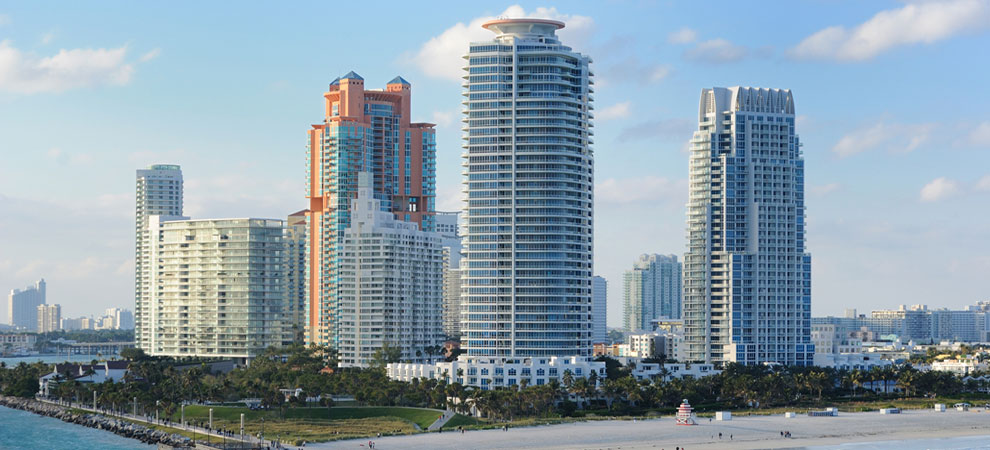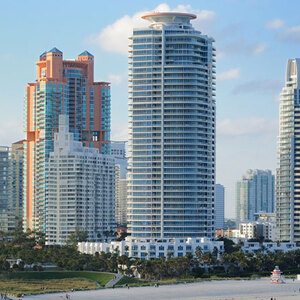Residential Real Estate News

Greater Miami Area Residential Sales Cool in March
Residential News » Miami Beach Edition | By Michael Gerrity | April 29, 2025 6:32 AM ET
Residential real estate sales in Miami-Dade County declined in March, as total transactions fell 6.5% year-over-year, according to the Miami Association of Realtors. Sales dropped from 2,141 closings in March 2024 to 2,002 this year.
Single-family home sales experienced a 7.7% decline, falling from 1,041 to 961 transactions. Despite the slower sales pace, Miami-Dade's total dollar volume rose 7.8% year-over-year to $2.1 billion, driven in part by rising home values. The median sales price for single-family homes climbed 3.1% over the past year, reaching $670,000, marking the 160th consecutive month of price increases--a record 13.3-year streak. Since March 2015, single-family prices have surged 167.3%, rising from $260,000.
The condominium market also saw a 5.4% decline in sales, from 1,100 to 1,041 transactions. Financing challenges continue to weigh on the condo sector, as just 0.9% of condominium buildings across Miami-Dade, Broward, and Palm Beach counties are approved for FHA loans, according to HUD data. Florida remains the only state that requires a 25% down payment for limited condo reviews when reserves are insufficient compared to just 10% elsewhere. Over the past decade, condo median prices have jumped 103.5%, reaching $437,450, although they fell 1.7% year-over-year in March. Condo prices have either held steady or risen in 158 of the past 166 months.
Inventory levels have increased sharply but remain below pre-pandemic figures. Total active listings in Miami-Dade rose 42.6% year-over-year to 18,333, still 22% lower than March 2019. Single-family inventory climbed 40.6% to 5,296 listings, while condo inventory grew 43.5% to 13,037 listings, although still nearly 19% below 2019 levels.
The supply of inventory continues to signal shifting market dynamics. Single-family homes had a six-month supply in March, typically considered a balanced market, while condos posted a 13.2-month supply, favoring buyers. Nationally, housing inventory reached 1.33 million units at the end of March, a 19.8% increase year-over-year, according to the National Association of Realtors, with U.S. unsold inventory representing a four-month supply.
In terms of dollar volume, single-family home sales generated $1.3 billion, a 12.6% increase, while condominium sales totaled $876.9 million, up 1.7% from a year earlier.
Distressed sales remain rare in Miami. Foreclosures and short sales accounted for just 1.2% of total residential sales in March, up slightly from 0.8% last year, and far below the 70% share seen during the 2009 financial crisis. Miami's distressed sales percentage also remains well below the national average of 3%.
Other key sales metrics showed signs of cooling. The median percent of original list price received was 95.5% for single-family homes and 93.8% for condos. Single-family homes took a median of 39 days to go under contract, compared to 31 days a year ago. Condos took 58 days, up from 43. From listing to closing, single-family transactions closed in 76 days on average, while condos closed in 100 days.
Cash remains a dominant force in Miami's real estate market. Cash transactions represented 38.5% of all closed sales in March, up from 37.2% a year earlier and well above the national average of 26%. Among local transactions, 52.3% of condo purchases and 23.5% of single-family home sales were made in cash.
Despite March's slowdown in transaction volume, Miami's housing market continues to be partially buoyed by international buyer demand.
Sign Up Free | The WPJ Weekly Newsletter
Relevant real estate news.
Actionable market intelligence.
Right to your inbox every week.
Real Estate Listings Showcase
Related News Stories
Residential Real Estate Headlines
- SENTIENT MORTGAGE Consumer-to-Lender AI Matching Engine Commences Development
- U.S. Homes Sold at Slowest Pace in 6 Years in March, Demand Sluggish
- Trump Tariffs Test U.S. Housing Markets Reliance on International Trade
- India Home Prices Nationwide Climbed 9 Percent Annually in 2024
- U.S. Home Remodeling Industry Sentiment Declines in Early 2025
- Canadian Home Sales Slide in February Amid U.S. Trade Tensions
- Americans Spent $603 Billion on Home Remodeling Projects in 2024
- U.S. Mortgage Demand Spikes 20 Percent in Early April as Rates Drop
- Las Vegas Area Home Prices Uptick 4.3 Percent Annually in March
- Single-Family Rent Growth in U.S. Trends Upward in 2025
- U.S. Mortgage Rates Tick Down Post Trump Tariffs Commencement
- President Trump's 'Liberation Day' Tariffs Potential Impact on the U.S. Housing and Mortgage Markets
- Baby Boomers Biggest Cohort of U.S. Home Buyers in 2025 as Millennials Decline
- U.S. Monthly Housing Payments Hit Record High in 2025
- U.S. Pending Home Sales Uptick in February
- Global Prime Residential Rent Slowdown Continued in Late 2024
- Ireland Home Price Inflation Hits 8 Year High in Early 2025
- Existing Home Sales in America Uptick in February
- Great Miami Area Residential Sales Decline 15 Percent Annually in February
- Mortgage Rates Uptick in Mid-March, Ending 9-Week Decline in U.S.
- World Property Ventures Builds the Future of Real Estate with New Funding Round
- U.S. Builder Sentiment Declines Amid Economic Uncertainty and Rising Costs
- Black Homeownership Rates in U.S. Enjoy Largest Annual Increase of All Racial Groups
- Wealthy Renters Are Taking Over More of the U.S. Rental Market
- If U.S. Congress Does Not Extend NFIP Soon, Thousands of Daily Home Closings Impacted
- U.S. Mortgage Applications Spike 11 Percent in Early March
- Greater Palm Beach Area Residential Sales Rise in Early 2025
- New Apartments in U.S. Are Leasing at Slowest Pace on Record
- U.S. Mortgage Rates Drop to 4 Month Low in March
- Overall U.S. Mortgage Delinquency Rates Dip in December
- New Tariffs on Canada, Mexico to Impact U.S. Homebuilder Input Costs
- Monaco's Property Market: A Tale of Two Cities
- U.S. Home Purchase Cancellations Surge, 1 in 7 Sales Getting Canceled
- U.S. Pending Home Sales Hit Historic Low in Early 2025
- Greater Miami Area Residential Sales Dip in January
- Governor DeSantis Supports Ending Property Taxes in Florida
- WPV Aims to Become the Berkshire Hathaway of Real Estate Tech
- U.S. Home Sales Slump Continues in January
- Average Americans Spend 38 Percent of Monthly Income on Mortgage Payments
- Switzerland's Safe-Haven Appeal Grows with World's Wealthy Homebuyers





